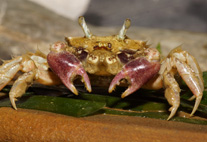Abstract
Tadpoles of Clinotarsus alticola collected nearby the type locality in Assam, India are barcoded and described. A detailed morphological and morphometrical description of the specimens, along with a study of the anatomy of the buccal cavity are provided. A comparison of these tadpoles with “Clinotarsus alticola” tadpoles from peninsular Thailand and of the genetic variation of a fragment of their mtDNA 16S gene led us to assign the population of peninsular Thailand to a new species, Clinotarsus penelope sp. n. The holotype of the new species is chosen among the tadpole series as no adult could be found in the type locality. Presumed conspecific adults of nearby localities are morphologically described and compared to barcoded adults of Clinotarsus alticola, waiting for further molecular confirmation. The tadpole of the new species differs from that of C. alticola by a much greater size at comparative stages (e.g., 77.7 mm vs. 53.3 mm in stage 36, respectively), a black coloration (vs. a yellow-olive tinge), several ocelli on the tail muscle (vs. only one), a rounded snout (vs. a more pointed snout) and a different Keratodont Row Formula (KRF; nine keratodonts rows maximum on both labia in C. penelope vs. eight maximum in C. alticola). A discussion about the choice of the holotype, the assignment of adult specimens and the future confirmation of this assignment are provided, as well as a comparison with older descriptions of “Clinotarsus alticola” sensu lato tadpoles and with Clinotarsus curtipes tadpoles from Karnataka, India. The lectotype of Clinotarsus alticola is redescribed.

